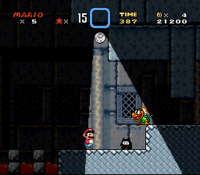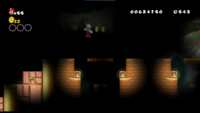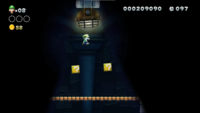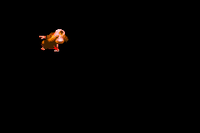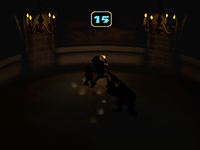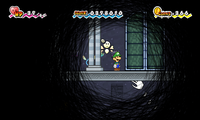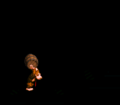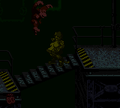Dark
This article is under construction. Therefore, please excuse its informal appearance while it is being worked on. We hope to have it completed as soon as possible.
- "Darkness" redirects here. It is not to be confused with Darkmess.
| Dark | |
|---|---|
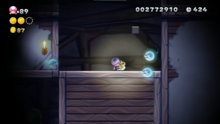 The dark in New Super Mario Bros. U Deluxe | |
| First appearance | Super Mario Bros. 3 (1988) |
| Latest appearance | Super Mario Bros. Wonder (2023) |
In the Super Mario franchise, the dark is a recurring obstacle, representing player characters' reduced range of vision in low light.
Player characters and other important entities, such as enemies, coins, and power-ups, often appear lit to remain visible to the player. In this case, the dark mainly obscures the terrain, leaving pits unmarked and making projectiles' trajectories harder to predict. The exact lighting effect used for this has depended on hardware limitations and stylistic considerations. Many games use a spotlight effect.
Emissive objects increase the range of vision in the dark. Some, such as Light Boxes, can also defeat light-sensitive enemies. After touching a Super Star, Invincible Mario illuminates the entire screen, clearing the dark until the invincibility expires.
The dark has a more aesthetic than mechanical effect in some games. For example, in some games in the Mario Kart series, karts' headlights will turn on in dark areas, but the visibility is relatively good regardless.
History[edit]
Super Mario series[edit]
Super Mario Bros. 3[edit]
In Super Mario Bros. 3, the third overworld screen of Dark Land is shrouded in darkness, with only the player's vicinity lit in a circle. In Super Mario Advance 4: Super Mario Bros. 3, this circle expands while the lock on the same screen is undone. Unlike later games, the levels themselves are not darker than expected.
Super Mario World[edit]
In Super Mario World, the final room of Bowser's Castle before the battle with Bowser is dimly lit. A spotlight[1] below the Item Stock casts a beam of light down across the center of the screen, rocking back and forth. The dark room is accessed directly though the Back Door, with slight alterations from the Front Door layout.
Super Mario 64 DS[edit]
In Super Mario 64 DS, darkness is used in the Hide and Boo Seek minigame. The player has to wipe away the darkness to reveal the hidden Boos. This minigame returns in New Super Mario Bros.
New Super Mario Bros. Wii[edit]
The dark occurs in multiple courses in New Super Mario Bros. Wii. It is first present in the main underground area of World 2-3, which demonstrates that it is warded off by the fireballs of Fire Mario, Fire Piranha Plants, Fire Snakes, and Fire Bros, as well as torches in the ground.
Glow Blocks increase the holder's range of vision. They appear in World 2-5, World 5-![]() Ghost House, World 6-6, and World 8-4.
Ghost House, World 6-6, and World 8-4.
World 8-4 introduces bioluminescent enemies: Bulbers and Jellybeams.
Super Mario Galaxy 2[edit]
In Super Mario Galaxy 2, Flash Black Galaxy is pitch-black; a flash of light illuminates the course every eight beats of the background music. Entities that are not part of the terrain proper, such as player characters, items, enemies, and Empty Blocks, are always shown at full brightness. Parts of the background are also dimly lit, which can provide contrast with the pitch-black terrain. However, the back wall of the tower makes this less effective.
New Super Mario Bros. U / New Super Luigi U / New Super Mario Bros. U Deluxe[edit]
The dark returns in New Super Mario Bros. U, New Super Luigi U, and New Super Mario Bros. U Deluxe, serving as the same visual hazard as in New Super Mario Bros. Wii in all three games. The player(s) are able to temporarily push back the dark with Glowing Baby Yoshis.
Super Mario Maker 2[edit]
In Super Mario Maker 2, dark sub-areas occur with the Underwater (night) and Ghost House (night) course themes. A small radius around player characters and certain objects is lit up; this radius changes based on the state of the ON/OFF Switch.
Super Mario 3D World[edit]
In Super Mario 3D World, the dark occurs in Switchblack Ruins, illuminated by torches, lava, and Fire Piranha Plants. It returns in later levels, A Beam in the Dark and Deep-Black Jungle Drift, where players can use the Light Box to cast a beam of light.
Super Mario Bros. Wonder[edit]
There are two types of darkness in Super Mario Bros. Wonder: the first and most common renders all elements as silhouettes, causing objects on the same plane to blend into one another and obscure most identifying details with some exceptions, such as characters' eyes or Piranha Plants' teeth, similar to Donkey Kong Country Returns. An area can appear this way by default, or darkness may be turned on or off by a Wonder Flower or ON/OFF Switch. The second type obscures the entire level in darkness except for the player. Elements such as fire and electricity can light the way; enemies that walk through electric currents become light sources themselves. In Pull, Turn, Burn and High-Voltage Gauntlet, their respective Wonder Effects can grant the player a fiery shield or the Metal Mario transformation (allowing them to conduct electricity) to light the way.
Hotel Mario[edit]
- “You bring a light?”
- —Luigi, Hotel Mario
In Hotel Mario, Roy's HardBrick Hotel has flickering lights due to a room full of toasters using too much electricity. In hallways with windows, the visibility is unaffected by the power going out.
Some stages of Larry's Chillton Hotel also feature the dark. Floors other than the one that Mario is currently on are dimly lit.
Donkey Kong Country[edit]
In Donkey Kong Country, the level Blackout Basement uses the dark by obscuring both the level's terrain and enemies.
Mario Party series[edit]
Mario Party[edit]
In the Mario Party minigame Pedal Power, the player starts in a dark room and has to pedal a stationary bike to power a light and prevent a Boo from catching them.
Mario Party 2[edit]
In Mario Party 2, darkness is used in the Lights Out minigame. When the room occasionally becomes dark, only the players carrying lightbulbs remain visible.
Mario Party 4[edit]
In Mario Party 4, the Candlelight Flight minigame takes place in a dark room. The solo player carries a candle which becomes dimmer as the other three players spray water on it.
Mario Party 6[edit]
In the Mario Party 6 minigame Light Up My Night, darkness is used to obscure the candles within the maze.
Mario Party 7[edit]
In Mario Party 7, the Ghost in the Hall minigame has players navigate a dark maze-like mansion.
Mario Party 10[edit]
In Mario Party 10, it occurs in the minigame Murky Maze, wherein the players use Glow Blocks to navigate a dark maze.
Paper Mario series[edit]
Paper Mario[edit]
During Chapter 4 of Paper Mario, darkness is incorporated in the battle with the Big Lantern Ghost. While the Big Lantern Ghost is obscured in darkness, Mario and his partner are unable to attack him. In order to dissipate the darkness, they need to repeatedly hit his lantern. The Big Lantern Ghost is able to blow into his lantern, causing the room to become dark again.
The Big Lantern Ghost's room, the room preceding General Guy's room, the interior of the whale, the cave where the green member of the Fearsome 5 is trapped, and the cavernous room in Bowser's Castle are all dark. In order to illuminate them, Mario needs to use Watt's ability.
Super Paper Mario[edit]
In Chapter 7-2 of Super Paper Mario, the Underwhere Road, the dark obscures certain rooms. The dark is stylized as an animated scribble around the player character.
Paper Mario: Sticker Star[edit]
In Paper Mario: Sticker Star, the basement of one of the warehouses in Surfshine Harbor is obscured in darkness. The player must paperize and use a Lightbulb sticker to light up the room and reveal the Ship's Wheel.
Paper Mario: Color Splash[edit]
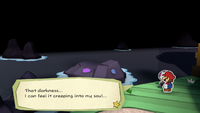
In Paper Mario: Color Splash, a solid wall of darkness obscures the world past Lighthouse Island. By fixing the lighthouse by using the cutout ability and placing a Lightbulb Battle Card, the lighthouse dissipates the darkness and reveals a Mini Paint Star in the process.
Gallery[edit]
Names in other languages[edit]
| Language | Name | Meaning |
|---|---|---|
| Japanese | くらやみ Kurayami |
Darkness |
See also[edit]
References[edit]
- ^ M. Arakawa. Nintendo Mario Mania Player's Guide. Page 147.
- Hazardous objects
- Hotel Mario
- New Super Mario Bros. Wii objects
- New Super Mario Bros. U objects
- Super Mario Bros. 3 objects
- Super Mario Bros. Wonder objects
- Super Mario Maker 2 objects
- Super Mario Galaxy 2 objects
- Super Mario 3D World objects
- Super Mario 3D World + Bowser's Fury
- Super Mario World objects
- Super Paper Mario objects
- Mario Party 10
